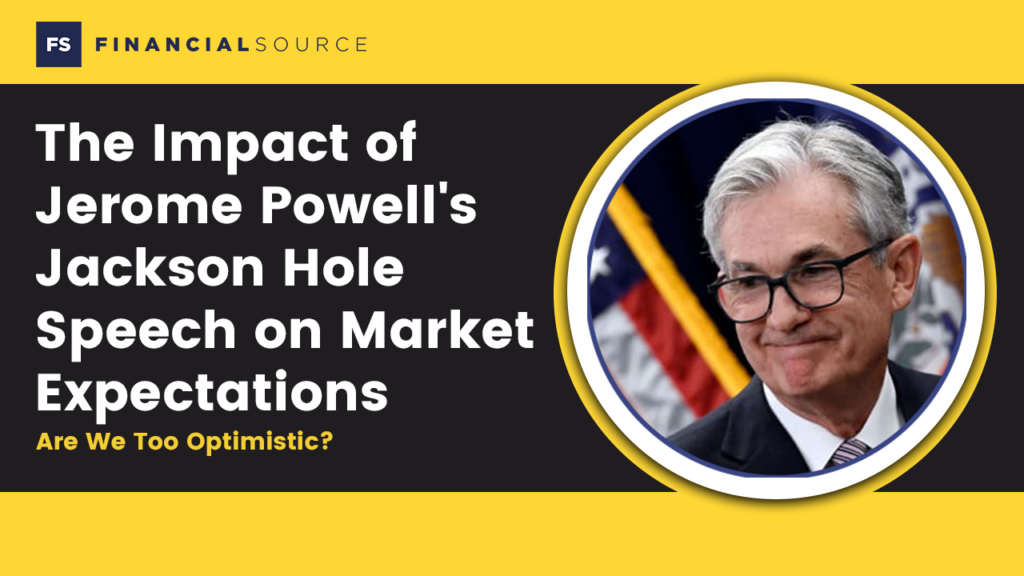The Impact of Jerome Powell's Jackson Hole Speech on Market Expectations: Are We Too Optimistic?

As Jerome Powell’s highly anticipated speech at the Jackson Hole Symposium approaches, traders and investors are on edge, eager to decipher the Federal Reserve Chairman’s next move. Scheduled for 3 PM UK time (10 AM EDT), Powell’s address is expected to offer crucial insights into the Fed’s future monetary policy, particularly regarding interest rates. With short-term interest rate markets pricing in multiple rate cuts by the end of the year, the stakes are high. But are these expectations realistic, or is there a risk of disappointment?
Market Expectations: A Dovish Powell?
The current market sentiment leans toward Powell delivering a dovish message, signaling that the Fed may soon ease monetary policy. Several factors have fueled this expectation. Firstly, inflation appears to be cooling, giving the Fed some breathing room. Secondly, recent revisions to U.S. labor market data have revealed that the economy added 68,000 fewer jobs per month from March 2023 to March 2024 than initially reported. This brings the total job creation down from 2.9 million to just 2.1 million—a significant revision that suggests the labor market may be weaker than previously believed.
Given this context, traders are betting heavily on a series of rate cuts by the end of the year. Short-term interest rate markets are currently pricing in up to four cuts, which would reduce the federal funds rate to around 4.36% by year-end. This optimism has already driven the S&P 500 higher and put downward pressure on the U.S. dollar.
Additionally, markets are expecting a 25 basis point reduction at the September 18th Federal Reserve meeting, with some small chance of a more aggressive 50 basis point cut. However, these expectations could hinge on the upcoming August jobs data, due on September 6th, which will likely influence the Fed’s decision-making process. The Fed is expected to maintain its data-dependent approach, focusing on balancing inflation control with employment stability.
Potential Market Reaction
If Powell confirms these dovish expectations, signaling a potential 50 basis point rate cut in the near term, it’s likely that the S&P 500 will continue its upward momentum. Conversely, the U.S. dollar could weaken further, particularly against currencies like the euro, as traders adjust to a more accommodative Fed.
The Risks of Over-Optimism
However, there’s a real risk that the markets have gotten ahead of themselves. While inflation is moderating, it remains above the Fed’s 2% target. Moreover, the latest PMI data indicates that certain segments of the economy are still performing well, complicating the case for aggressive rate cuts.
The minutes from the Federal Open Market Committee (FOMC) meeting in July revealed that while some members considered a rate cut, the majority preferred to wait until September before making any decisions. This cautious approach suggests that Powell might not be as eager to cut rates as the markets hope. If Powell signals a preference for gradual easing and emphasizes the importance of preventing unexpected labor market weakness—a stance other Fed officials have recently taken—the markets could react sharply. The S&P 500, which has rallied on the expectation of dovish policy, could see a sell-off, and the U.S. dollar might strengthen as traders reassess their positions.
Potential Market Reaction: Should Powell indicate a more measured approach, with only modest cuts on the table, expect to see profit-taking in the S&P 500 and a possible bounce in the U.S. dollar. This could create short-term volatility as the markets adjust to the reality of a less aggressive Fed.
Balancing Expectations with Reality
The optimism surrounding potential rate cuts is based on a legitimate assessment of the current economic landscape. Inflation is cooling, and the labor market appears to be softening. However, it’s important to balance these factors with the reality that the Fed might not be as aggressive in cutting rates as some traders are hoping.
If Powell’s speech at Jackson Hole reflects the cautious sentiment expressed in the FOMC minutes, the markets could be in for a surprise. A more hawkish tone, or even just a signal of modest rate cuts, could lead to a rapid reassessment of market positions. The S&P 500 could face downside pressure, and the U.S. dollar might rally as traders unwind positions based on over-optimistic rate cut expectations.
Conclusion: Navigating the Uncertainty
Jerome Powell’s speech at Jackson Hole is set to be a defining moment for financial markets. The extent to which he signals a dovish shift will determine the near-term direction for the S&P 500, the U.S. dollar, and broader financial markets. Traders should be prepared for significant moves in either direction, depending on how Powell’s message aligns with current market expectations.
In this environment, flexibility and readiness to adapt will be key. While the markets are optimistic about the prospect of multiple rate cuts, it’s crucial to remain aware of the risks of over-optimism. Staying informed, being attuned to the nuances of Powell’s message, and responding swiftly to market reactions will be essential in navigating the potential volatility ahead. Whether Powell confirms the market’s hopes for aggressive rate cuts or tempers those expectations with a more cautious outlook, the reaction could set the tone for the remainder of the year.